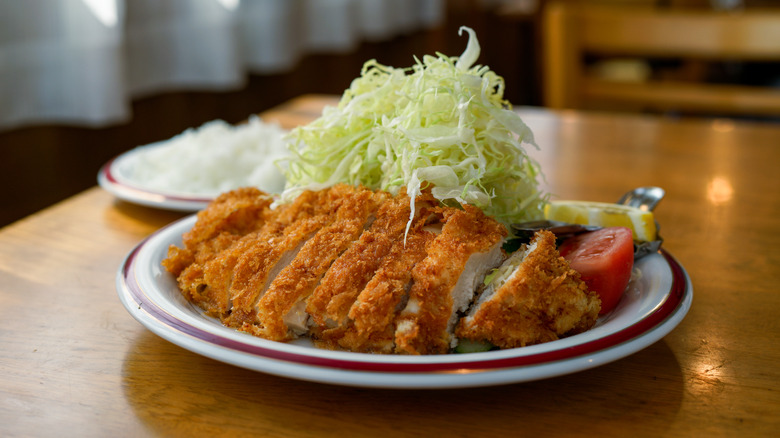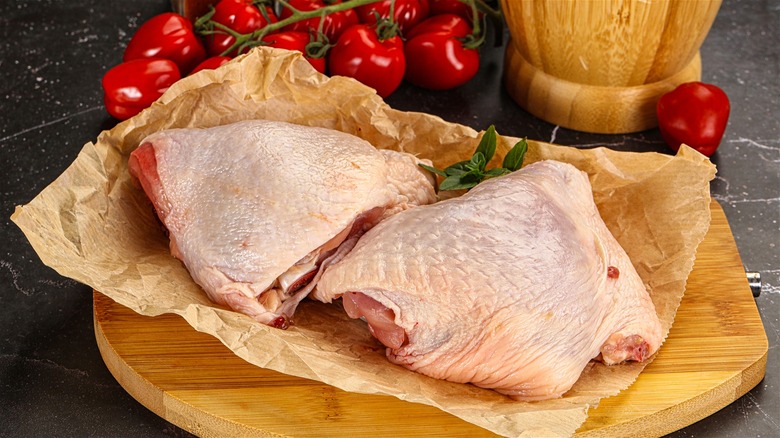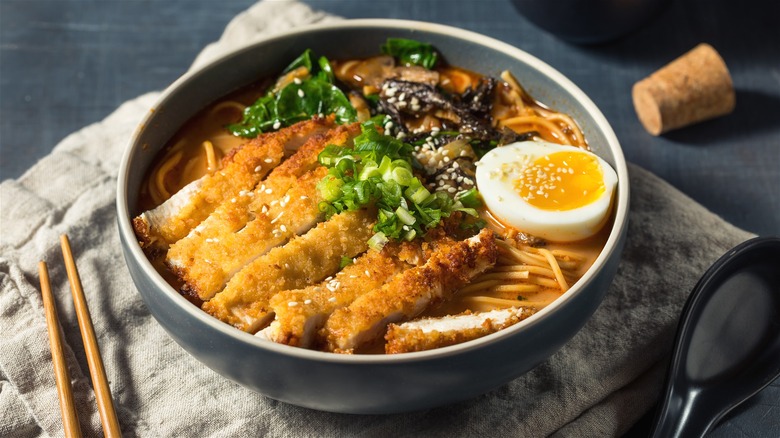For The Best Fried Chicken Katsu, Choose Dark Meat Every Time
Southern fried chicken isn't the only crispy poultry dish in the game. Katsu is a Japanese-style chicken cutlet flaunting a crisp, crumbly panko breadcrumb coating that gives way to tender, juicy meat. Although it's a commonly available provision at Japanese restaurants, it's easy to make chicken katsu at home. To ace Chicken Katsu 101, the first lesson you should master is selecting the right cut of meat.
Although chicken breast works fine for katsu, dark meat cuts are the superior selection. The more an animal's muscles are used, the more myoglobin they contain — a protein that facilitates meat with a more saturated color and a richer flavor profile. Being flightless birds, chickens exercise their legs more than any other part of their body, making thighs, drums, and whole legs their quintessential dark meat cuts. Dark meat also contains more fat than white meat, which makes it less prone to drying out during cooking. Using dark instead of white meat to make chicken katsu will help you achieve a flavor-packed, restaurant-worthy dish with a juicy, succulent texture — all encased in breadcrumbs.
Which dark meat cut works best for chicken katsu
Thighs, drumsticks, and whole legs are deliciously flavorful dark meat cuts that shine in many different recipes. When making chicken katsu, however, there are some key differences between the cuts worth considering, primarily concerning the ease of preparation.
Proper chicken katsu is always prepared from a cutlet — a thin, boneless, and skinless piece of meat (think chicken schnitzel). Because it's widely available without bones and skins, chicken thighs are the most practical cut of dark chicken meat to use in a katsu recipe. Drumsticks and whole legs, on the other hand, are typically sold bone-in, necessitating manual removal. Similarly, thighs are already in a relatively flat shape, making them ideal for pounding into uniform cutlets for evenly-cooked chicken katsu. Tenderizing a drumstick or whole leg is trickier, due to their respective cylindrical and irregular shapes.
While thighs provide the most convenience and ideal texture for chicken katsu, drumsticks, and whole legs can be used with additional effort. If you opt for these cuts, ensure thorough deboning and flattening to achieve a desirable katsu texture.
Pairing dark meat chicken katsu
What's fried chicken without some complementary sides and pairings? Luckily, there is a bounty of provisions that marry well with the rich taste of dark-meat chicken katsu.
To keep things traditional, serve dark meat chicken katsu with tonkatsu sauce – a savory, tangy Japanese barbecue sauce fashioned with fruits and veggies such as tomatoes, apples, and onions — alongside vinegar, soy sauce, and sugar. The complex and surprisingly uplifting taste of tonkatsu sauce is the perfect accompaniment to the meaty machismo of dark meat — just don't forget a side of shredded cabbage for a hint of garden-fresh goodness to round out the meal. Bonus points for transforming that plain shredded cabbage into a zippy Asian-inspired coleslaw.
Consider also making chicken katsu don – a chicken and egg dish served over rice. Starchy jasmine rice can help soak up the decadent juices of the meat, giving the grains a much-needed depth of flavor, while ensuring that not a single drop of katsu is missed. Garnish with crunchy green onions and pickled jalapeños for a peppery and fiery kick, to combat the heartiness of the other ingredients.
If neither option suits your tastes, simply look to starches, vegetables, pickled produce, and zesty sauces to contrast the rich, meaty flavor of dark meat chicken katsu. Whether it's a side of stir-fried bok choy, a bed of ramen noodles, or a generous drizzle of chili crisp, there's no shortage of pairing options.


